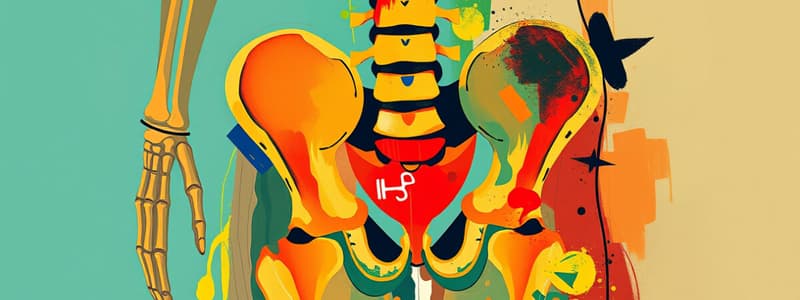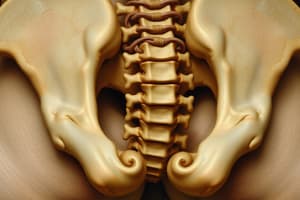Podcast
Questions and Answers
Bruising is not a sign of pelvic injuries.
Bruising is not a sign of pelvic injuries.
False (B)
Hypovolemic shock can be a symptom of pelvic injuries.
Hypovolemic shock can be a symptom of pelvic injuries.
True (A)
Pelvic splints can be reused after cleaning.
Pelvic splints can be reused after cleaning.
False (B)
Movement should be maximized when treating pelvic injuries.
Movement should be maximized when treating pelvic injuries.
Signup and view all the answers
Altered sensation in one leg can be a sign of a pelvic injury.
Altered sensation in one leg can be a sign of a pelvic injury.
Signup and view all the answers
A pelvic splint should be removed once it has been applied.
A pelvic splint should be removed once it has been applied.
Signup and view all the answers
Immediate splinting of pelvic injuries is not necessary for proper care.
Immediate splinting of pelvic injuries is not necessary for proper care.
Signup and view all the answers
Managing airway during pelvic injury treatment does not require consideration of the c-spine.
Managing airway during pelvic injury treatment does not require consideration of the c-spine.
Signup and view all the answers
Pelvic fractures account for 10-15% of all fractures in adults.
Pelvic fractures account for 10-15% of all fractures in adults.
Signup and view all the answers
Haemorrhage is the leading cause of death in 40% of pelvic trauma patients.
Haemorrhage is the leading cause of death in 40% of pelvic trauma patients.
Signup and view all the answers
A significant door intrusion into the passenger space is a minor concern in an RTC.
A significant door intrusion into the passenger space is a minor concern in an RTC.
Signup and view all the answers
Falls from high places can sometimes cause pelvic injuries.
Falls from high places can sometimes cause pelvic injuries.
Signup and view all the answers
Vascular injuries related to pelvic fractures do not typically cause haemorrhage.
Vascular injuries related to pelvic fractures do not typically cause haemorrhage.
Signup and view all the answers
Bladder rupture occurs in about 25% of urogenital injuries associated with pelvic fractures.
Bladder rupture occurs in about 25% of urogenital injuries associated with pelvic fractures.
Signup and view all the answers
Pelvic injuries are equally common in men and women.
Pelvic injuries are equally common in men and women.
Signup and view all the answers
Simple falls can lead to pelvic injuries, especially in individuals with certain risk factors.
Simple falls can lead to pelvic injuries, especially in individuals with certain risk factors.
Signup and view all the answers
46% of spinal injuries occur from falls that are less than 2 metres.
46% of spinal injuries occur from falls that are less than 2 metres.
Signup and view all the answers
Road traffic collisions account for 60% of spinal injuries.
Road traffic collisions account for 60% of spinal injuries.
Signup and view all the answers
Compression and stretching of the spinal cord can result from dislocation of vertebrae.
Compression and stretching of the spinal cord can result from dislocation of vertebrae.
Signup and view all the answers
Neurogenic shock can occur after a spinal cord injury due to loss of sympathetic tone.
Neurogenic shock can occur after a spinal cord injury due to loss of sympathetic tone.
Signup and view all the answers
A bulging disc is synonymous with a herniated disc.
A bulging disc is synonymous with a herniated disc.
Signup and view all the answers
Cauda Equina Syndrome requires urgent decompression in all cases.
Cauda Equina Syndrome requires urgent decompression in all cases.
Signup and view all the answers
Loss of motor function during spinal shock is temporary and recovery is unlikely.
Loss of motor function during spinal shock is temporary and recovery is unlikely.
Signup and view all the answers
Infection can be a cause of spinal injuries.
Infection can be a cause of spinal injuries.
Signup and view all the answers
Hypotension is an uncommon sign associated with spinal injury.
Hypotension is an uncommon sign associated with spinal injury.
Signup and view all the answers
Spinal tumours can cause compression of the spinal cord.
Spinal tumours can cause compression of the spinal cord.
Signup and view all the answers
A third of falls resulting in spinal injuries are from heights greater than 2 metres.
A third of falls resulting in spinal injuries are from heights greater than 2 metres.
Signup and view all the answers
Saddle anesthesia is a clinical red flag for Cauda Equina Syndrome.
Saddle anesthesia is a clinical red flag for Cauda Equina Syndrome.
Signup and view all the answers
In spinal injury cases, bladder dysfunction is a common clinical red flag.
In spinal injury cases, bladder dysfunction is a common clinical red flag.
Signup and view all the answers
Respiratory difficulties can occur due to damage to the lower cervical cord.
Respiratory difficulties can occur due to damage to the lower cervical cord.
Signup and view all the answers
Stretching of the spinal cord can lead to spinal cord injury in the event of vertebral displacement.
Stretching of the spinal cord can lead to spinal cord injury in the event of vertebral displacement.
Signup and view all the answers
Study Notes
Pelvic Injuries
- Pelvic fractures make up 3-6% of all adult fractures and occur in 20% of polytrauma cases.
- Approximately 75% of pelvic injuries happen to men.
- Haemorrhage accounts for 40% of deaths in pelvic trauma patients.
Causes of Pelvic Injuries
- Common mechanisms include high-energy transfers (e.g., road traffic collisions), falls from height, and crush injuries.
- Simple falls can cause injuries, particularly in the elderly or those with degenerative bone diseases or undergoing radiotherapy.
Complications of Pelvic Injuries
- Increased pelvic volume from fractures can lead to significant haemorrhage.
- Other potential complications include vascular injuries, urogenital injuries (10% risk of bladder rupture), and concurrent intra-thoracic or intra-abdominal injuries.
Signs & Symptoms of Pelvic Injuries
- Symptoms include bruising, rectal/vaginal/urethral bleeding, deformity, swelling, limb shortening, hip/groin/lower back pain, hypovolemic shock, and altered sensation in one leg.
Management of Pelvic Injuries
- Immediate management includes following DRABC protocols and applying a pelvic splint.
- Control catastrophic haemorrhage, provide high-flow oxygen, and ensure pain relief.
- Avoid repeated examinations that may dislodge blood clots and do not remove pelvic splints once applied.
- Successful splinting allows for safe transport to a major trauma center (MTC).
Spinal Injuries
- Spinal injuries result from mechanisms such as hyperflexion, hyperextension, rotation, or compression, with combinations of these prevalent.
- Falls account for 46% of spinal injuries, particularly among older individuals, while road traffic collisions account for 40%.
Types of Spinal Injuries
- Types include vertebral dislocation, fracture, and displacement, all of which can compress or stretch the spinal cord, leading to Spinal Cord Injury (SCI).
Complications of Spinal Injuries
- Potential complications include damage to the spinal cord, spinal shock, neurogenic shock, respiratory difficulties, and Cauda Equina Syndrome, which requires urgent surgical intervention.
Signs & Symptoms of Spinal Injury
- Common signs include pain along the spine, loss of sensation or movement in limbs, and altered sensations such as pins and needles or electric shock feelings.
- Specific symptoms indicating lower back injury such as saddle anesthesia, bladder/bowel dysfunction, and lower limb weakness should be closely monitored.
Additional Considerations
- Spinal shock indicates complete loss of motor and potentially sensory function, with recovery possible over time.
- Neurogenic shock features poor tissue perfusion due to loss of sympathetic tone, affecting overall stability following spinal cord injury.
Studying That Suits You
Use AI to generate personalized quizzes and flashcards to suit your learning preferences.
Description
This quiz focuses on identifying the mechanisms of pelvic and spinal injuries, along with their signs, symptoms, and management strategies. Understanding these components is crucial for effective trauma care in emergency and urgent settings. Test your knowledge and improve your skills in managing these critical injuries.




